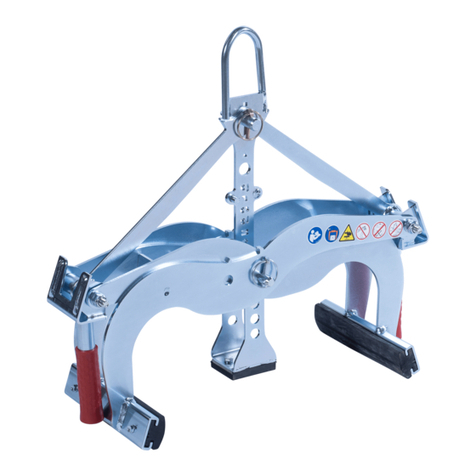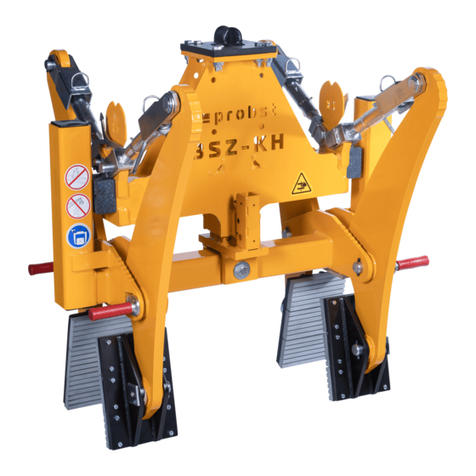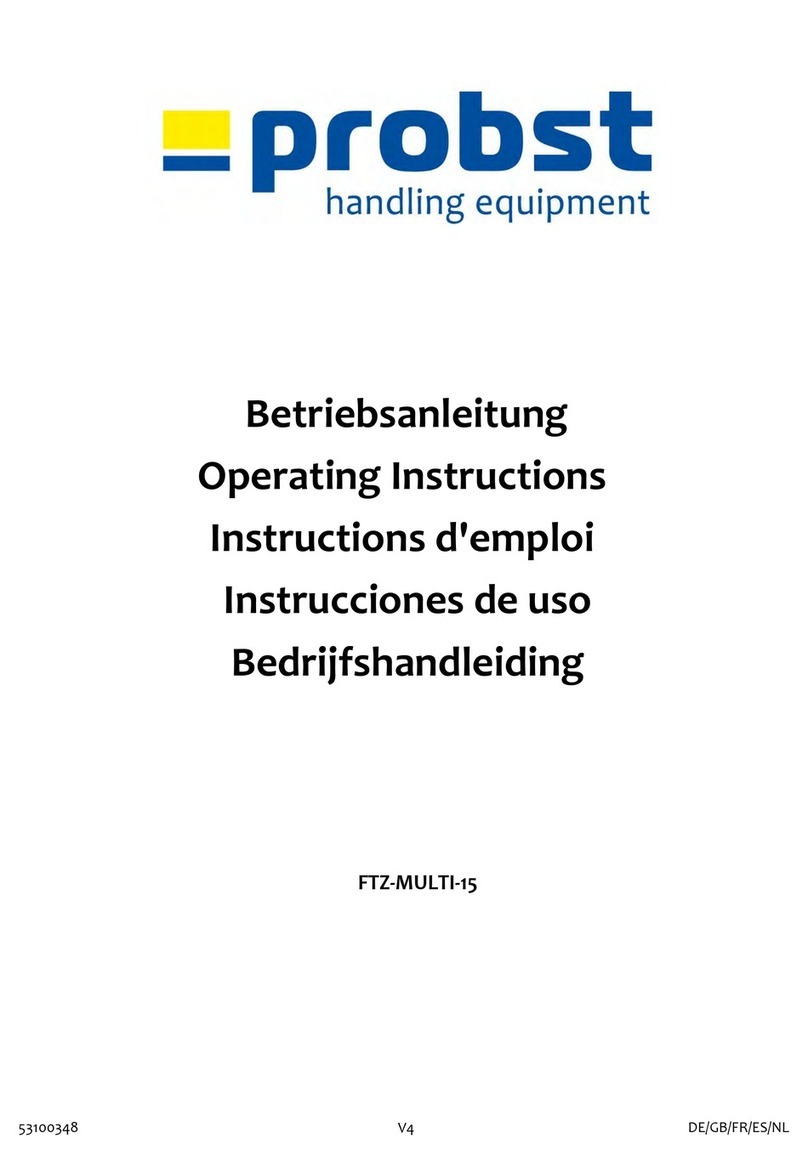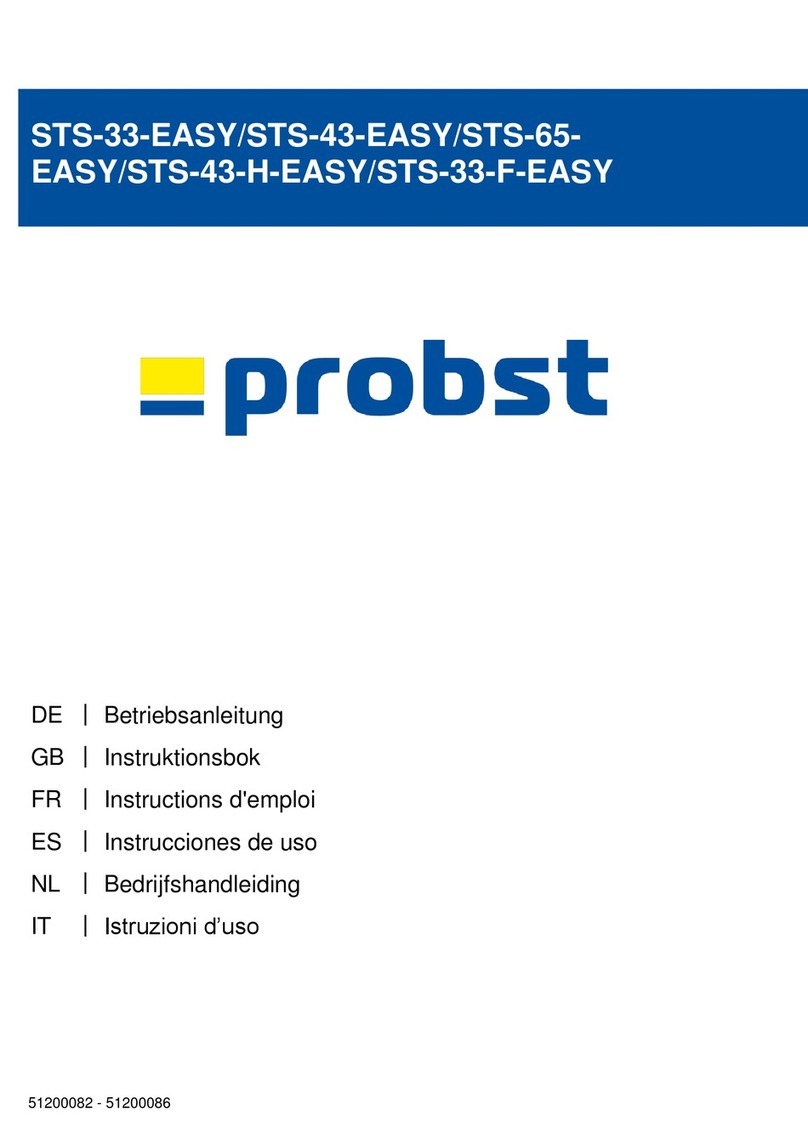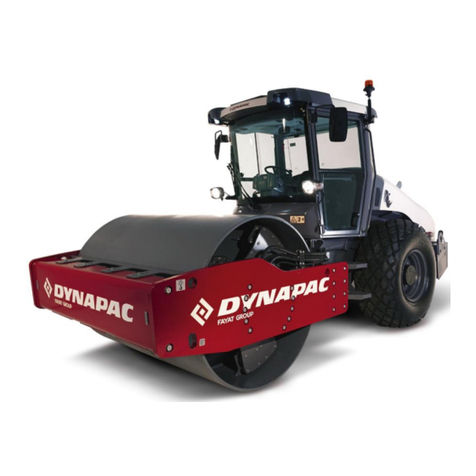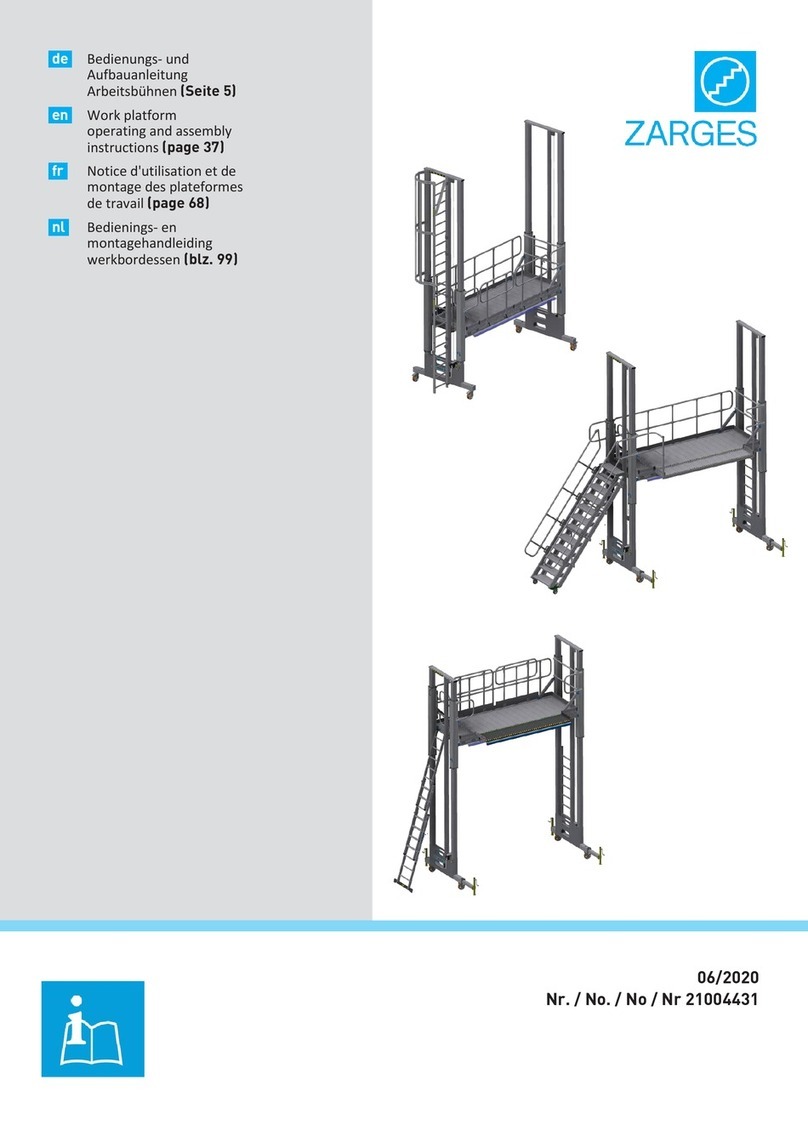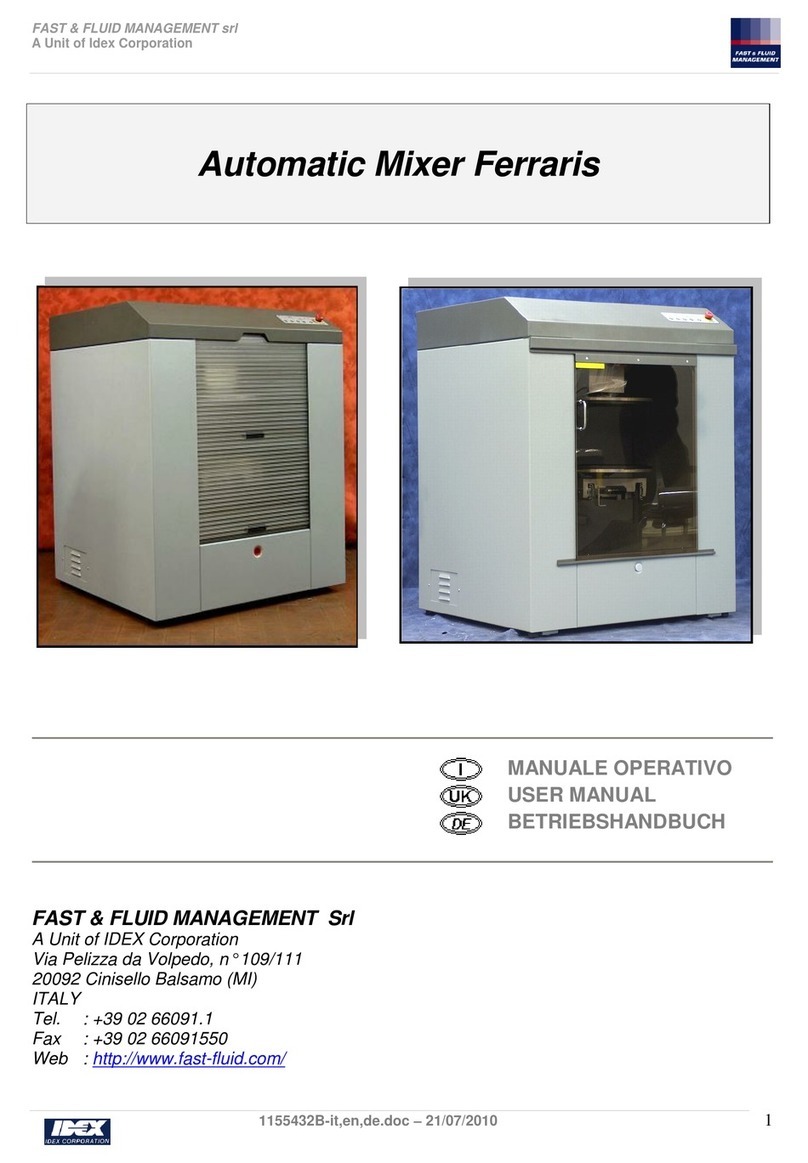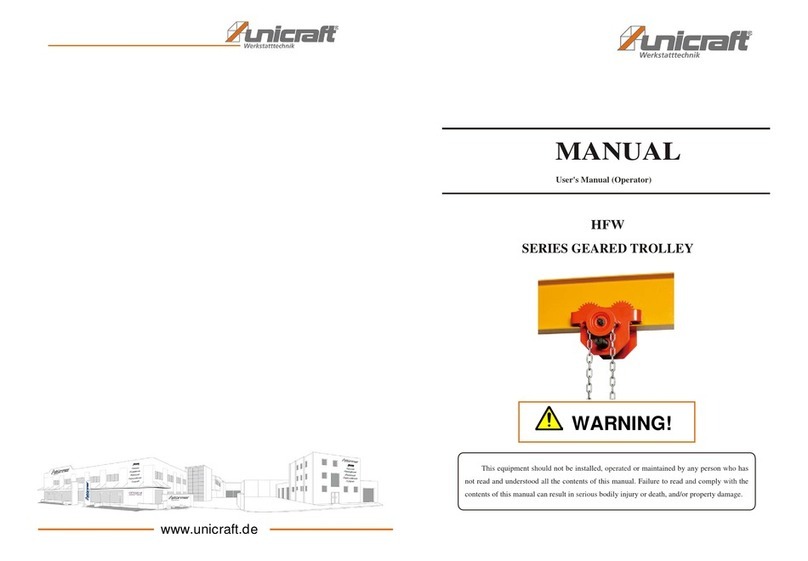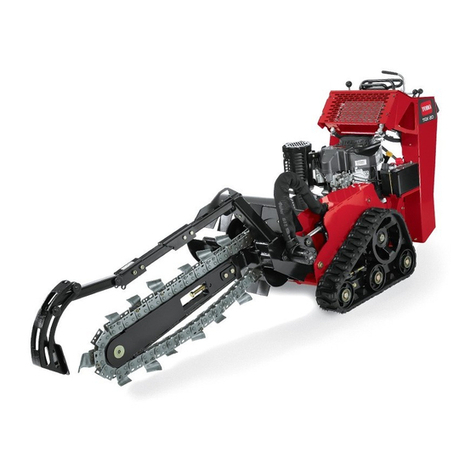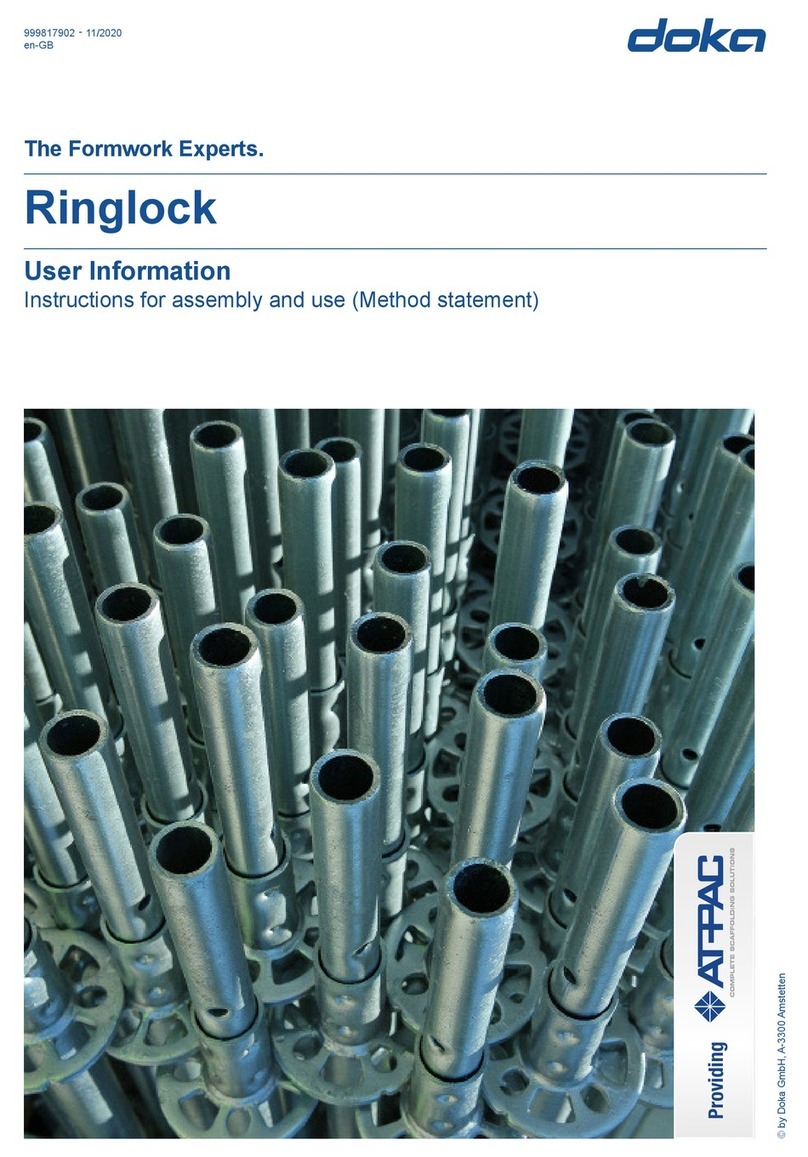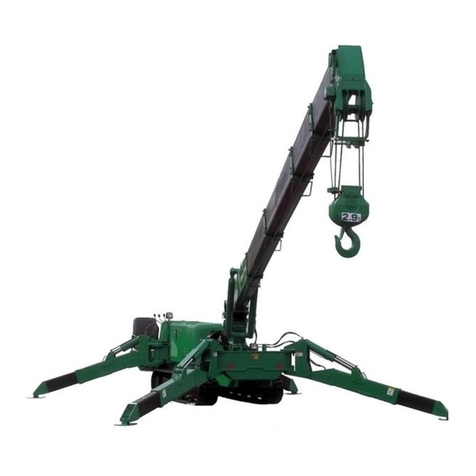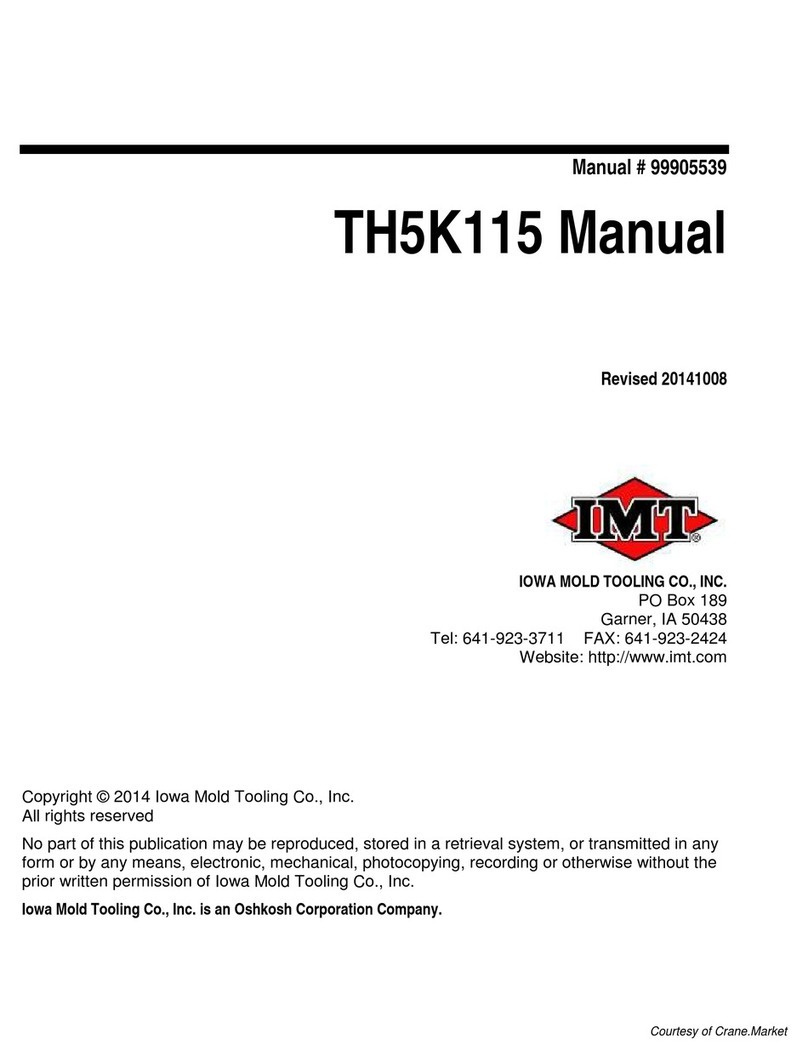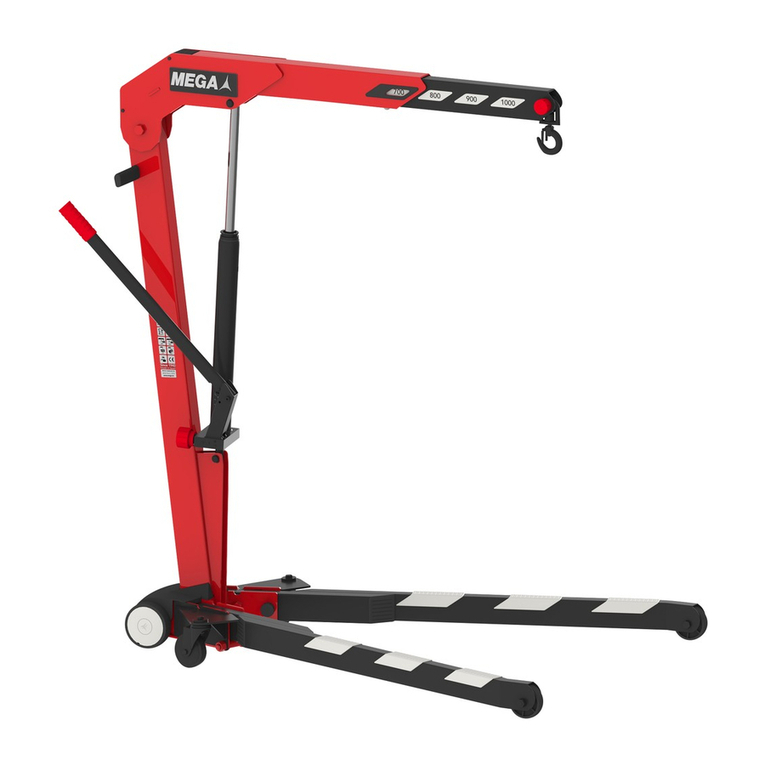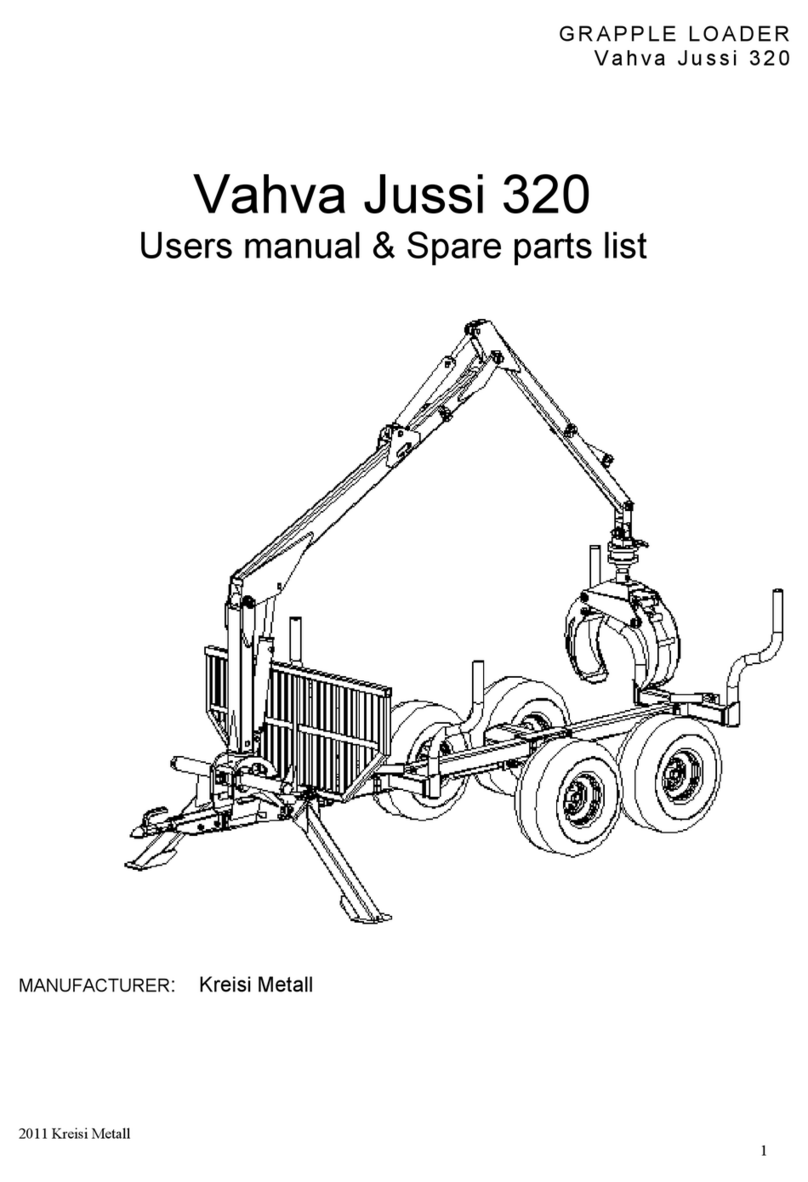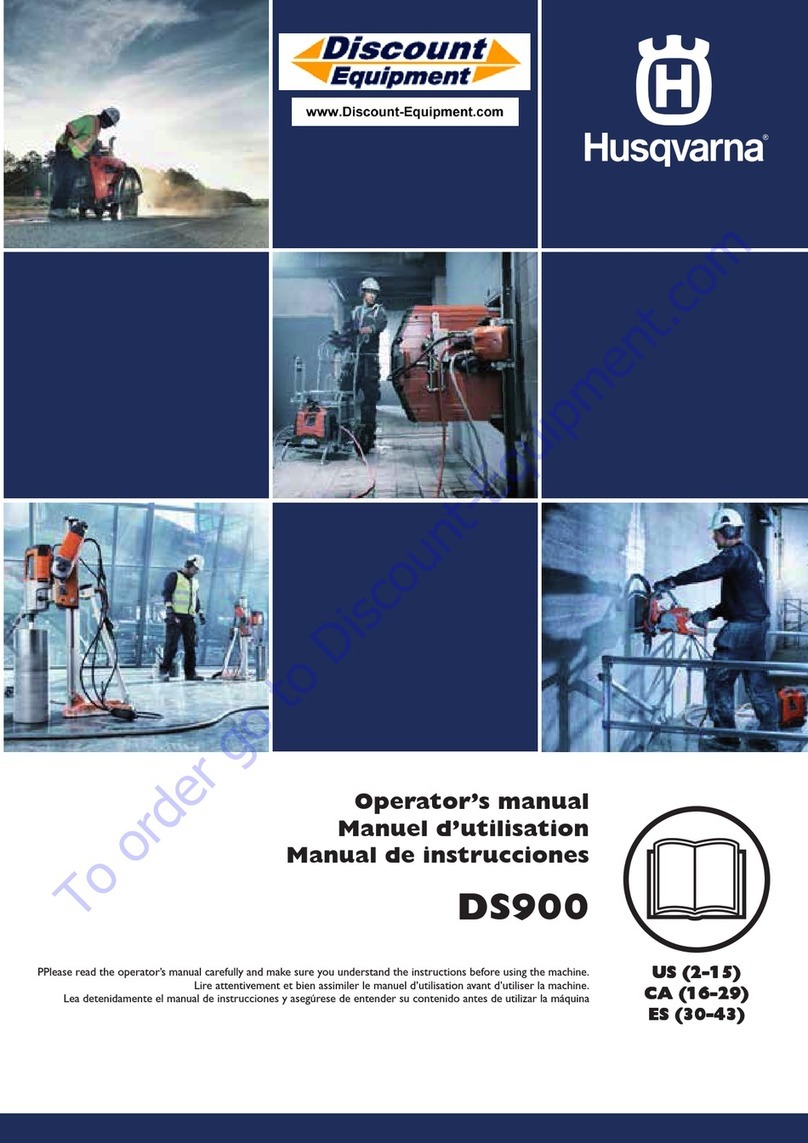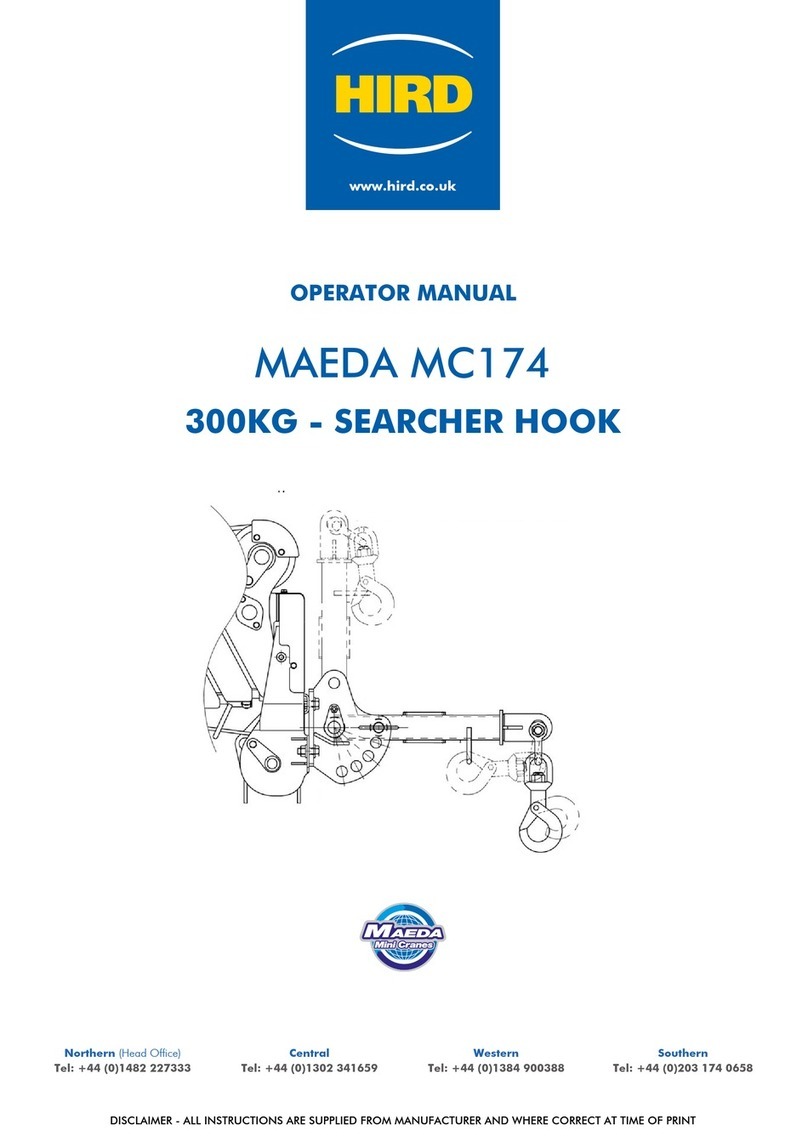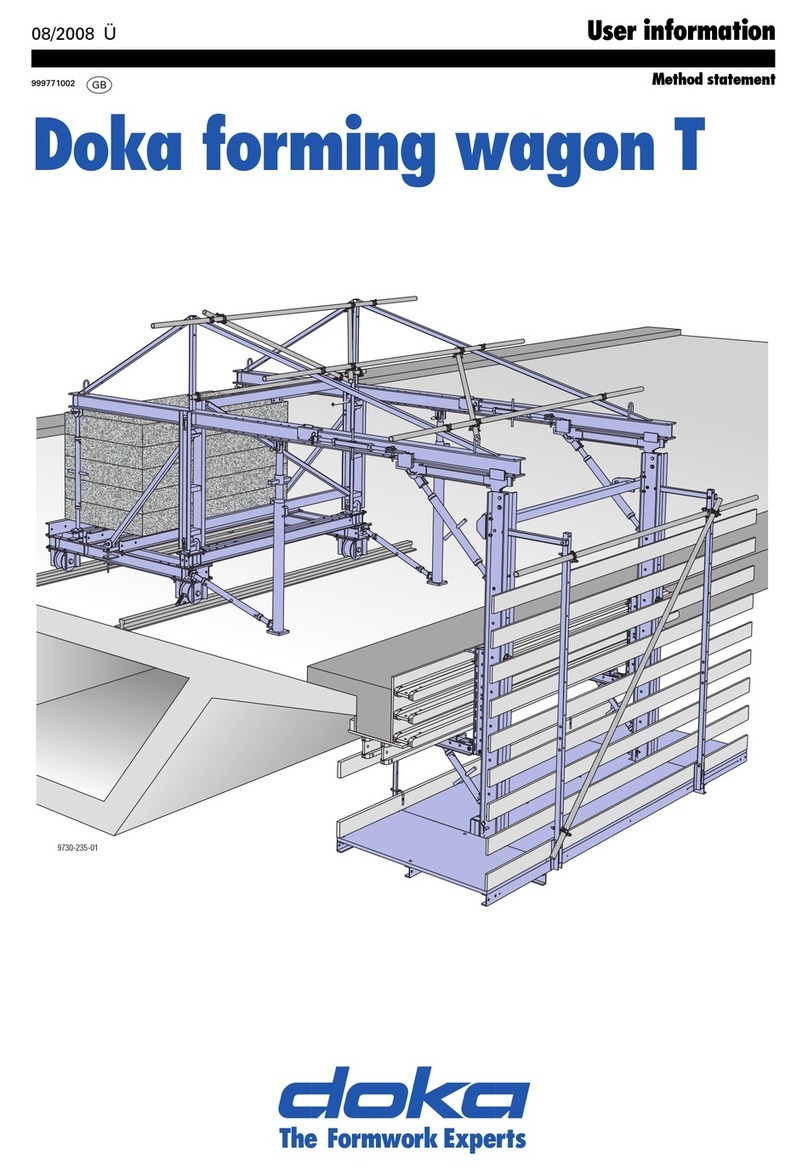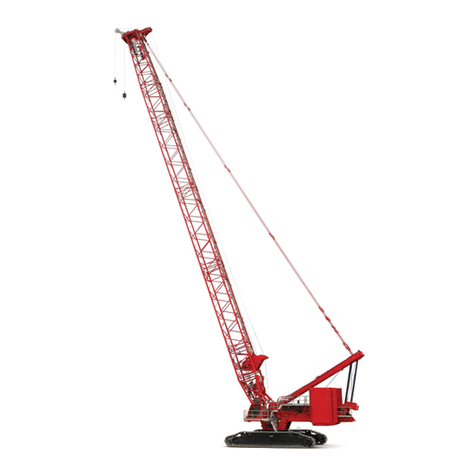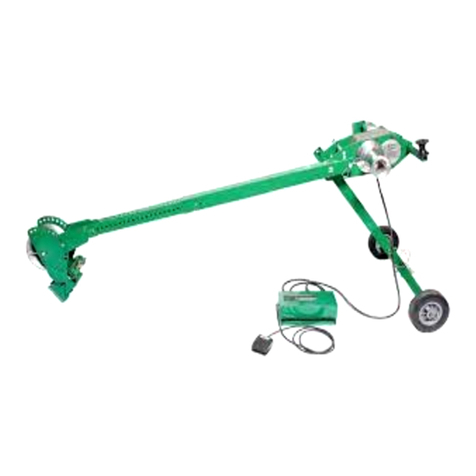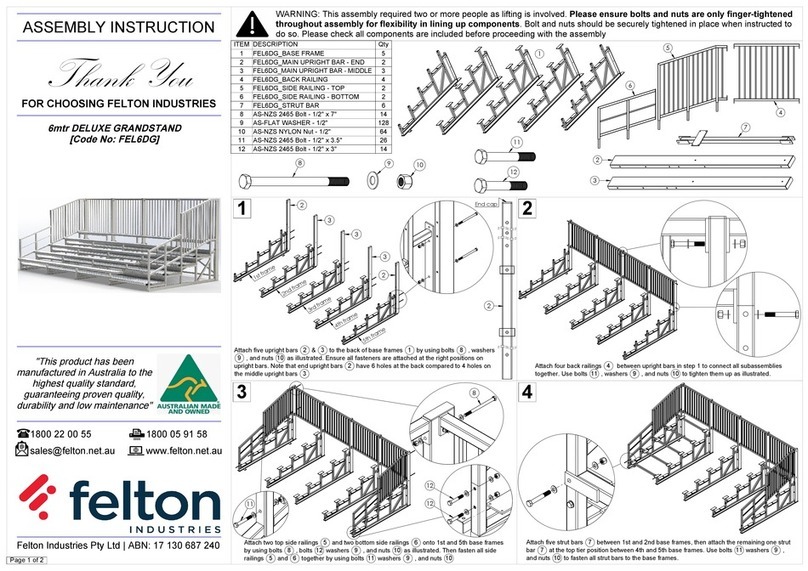probst POWERPLAN PP User manual

PP
PP
V2
51300001
POWERPLAN PP Screeding Machine
Translation of original operating instructions
GB
POWERPLAN PP Screeding Machine
Operating Instructions
5130.0011
V4
PP

Bitte beachten Sie, dass das Produkt ohne vorliegende Betriebsanleitung in Landessprache nicht
eingesetzt / in Betrieb gesetzt werden darf. Sollten Sie mit der Lieferung des Produkts keine
Betriebsanleitung in Ihrer Landessprache erhalten haben, kontaktieren Sie uns bitte. In Länder der
EU / EFTA senden wir Ihnen diese kostenlos nach. Für Länder außerhalb der EU / EFTA erstellen wir
Ihnen gerne ein Angebot für eine Betriebsanleitung in Landessprache, falls die Übersetzung nicht
durch den Händler/Importeur organisiert werden kann.
Please note that the product may not be used / put into operation without these operating
instructions in the national language. If you did not receive operating instructions in your national
language with the delivery of the product, please contact us. In countries of the EU / EFTA we will
send them to you free of charge. For countries outside the EU / EFTA, we will be pleased to provide
you with an offer for an operating manual in the national language if the translation cannot be
organised by the dealer/importer.

Operating Instructions
PP
2 / 73
V4
GB
1Contents
1Contents ................................................................................................................................................................. 2
2EC-Declaration of Conformity ............................................................................................................................... 5
3Safety......................................................................................................................................................................6
3.1 Information on these operating instructions .................................................................................................6
3.2 Hazard classification ........................................................................................................................................6
3.3 The structure of the safety information provided in this manual .................................................................6
3.4 Description of symbols and warning signs .....................................................................................................7
3.5 Overview of hazard symbols and information signs ......................................................................................8
3.5.1 Maintaining/caring for safety symbols and information signs ................................................................10
3.6 Personnel requirements ................................................................................................................................10
3.7 Personal safety...............................................................................................................................................10
3.7.1 Personal safety equipment .......................................................................................................................11
3.8 Accident prevention.......................................................................................................................................12
3.9 Hazard zone....................................................................................................................................................13
3.10 Testing the machine’s operation and performing a visual inspection ........................................................13
3.10.1 General information...................................................................................................................................13
3.10.2 Hydraulic pipes and connections ..............................................................................................................14
3.11 Driving and operating the machine...............................................................................................................14
3.11.1 Driving mode..............................................................................................................................................15
3.11.2 Screeding mode .........................................................................................................................................15
3.11.3 Laser safety class .......................................................................................................................................15
3.12 Guide...............................................................................................................................................................15
3.13 Working in closed spaces...............................................................................................................................15
3.14 Maintenance...................................................................................................................................................17
3.14.1 Hydraulic hoses and pipes .........................................................................................................................18
3.15 Fuel..................................................................................................................................................................18
3.16 Loading and transporting the machine.........................................................................................................19
4General.................................................................................................................................................................. 20
4.1 Correct use .....................................................................................................................................................20
4.2 Hints to the correct operation.......................................................................................................................20
4.3 Incorrect use...................................................................................................................................................21
4.4 Warranty.........................................................................................................................................................21
4.5 Overview and structure .................................................................................................................................22
4.6 Training ...........................................................................................................................................................23
4.7 Technical data.................................................................................................................................................24
4.7.1 Dimensions.................................................................................................................................................25
5Operating the machine........................................................................................................................................ 27
5.1 Driver’s cab.....................................................................................................................................................28
5.1.1 Overview of the driver’s cab .....................................................................................................................28
5.1.2 Operating equipment and indicators........................................................................................................29
5.1.3 Manual control unit ...................................................................................................................................30
5.2 Engine compartment .....................................................................................................................................31
5.2.1 Opening the engine hood..........................................................................................................................31

Operating Instructions
PP
3 / 73
V4
GB
5.2.2 Overview of the engine compartment .....................................................................................................32
5.3 Daily inspections.............................................................................................................................................33
5.3.1 Checking the fuel level...............................................................................................................................33
5.3.2 Checking the engine oil level.....................................................................................................................34
5.3.3 Checking the hydraulic fluid level .............................................................................................................35
5.3.4 Checking the coolant level ........................................................................................................................35
5.3.5 Cleaning the air filter .................................................................................................................................36
5.3.6 Checking the accelerator...........................................................................................................................38
5.4 Before starting the machine..........................................................................................................................38
5.4.1 Main switch ................................................................................................................................................38
5.5 Operation........................................................................................................................................................39
5.5.1 Inspections to be performed before starting the engine........................................................................39
5.5.2 Starting the engine ....................................................................................................................................41
5.5.3 Controlling engine speed ..........................................................................................................................42
5.5.4 Adjusting the damper speed for the front chute .....................................................................................43
5.5.5 Selecting the drive setting and driving mode...........................................................................................43
5.5.6 Starting to drive .........................................................................................................................................45
5.5.7 Chain guide.................................................................................................................................................45
5.5.8 Fitting/removing the smoothing and spreading board............................................................................46
5.5.9 Adjusting the adjustable panels ................................................................................................................47
5.5.10 Raising/lowering the smoothing board ....................................................................................................47
5.5.11 Switching the machine off ........................................................................................................................48
5.6 Transport ........................................................................................................................................................48
5.6.1 General information...................................................................................................................................48
5.6.2 Preparing the machine for transport........................................................................................................49
5.6.3 Taking down the driver’s cab roof ............................................................................................................49
5.6.4 Loading and transporting the machine. ...................................................................................................50
5.6.5 Lifting the machine ....................................................................................................................................52
6Maintenance and care ......................................................................................................................................... 53
6.1 Maintenance intervals....................................................................................................................................54
6.2 Maintenance plan...........................................................................................................................................55
6.3 Cleaning ..........................................................................................................................................................56
6.3.1 Dry-cleaning with compressed air.............................................................................................................57
6.3.2 Cleaning the machine with water and detergents...................................................................................57
6.3.3 Cleaning the machine with a pressure washer.........................................................................................57
6.3.4 Cleaning the outside of the engine...........................................................................................................57
6.4 Lubricating......................................................................................................................................................58
6.5 Maintenance work .........................................................................................................................................59
6.5.1 Changing the engine oil and oil filter ........................................................................................................59
6.5.2 Changing the hydraulic fluid and hydraulic fluid filter .............................................................................59
6.5.3 Maintaining the cooling system ................................................................................................................59
6.5.4 Maintaining the fuel system......................................................................................................................59
6.5.5 Checking the v-belt tension.......................................................................................................................59
6.5.6 Maintaining the crawler tracks .................................................................................................................60
6.5.7 Maintaining the battery.............................................................................................................................62

Operating Instructions
PP
4 / 73
V4
GB
6.5.8 Changing fuses...........................................................................................................................................66
6.5.9 Changing light bulbs ..................................................................................................................................68
6.6 If the machine is not used for a longer period of time / disposing of the machine ....................................69
6.6.1 If the machine is not used for a longer period of time ............................................................................69
6.6.2 Disposal ......................................................................................................................................................69
6.7 Repairing faults ..............................................................................................................................................70
6.8 Duty of inspection ..........................................................................................................................................72
6.9 Information on the type plate .......................................................................................................................73
6.10 Information on hiring out PROBST machinery .............................................................................................73

Operating Instructions
PP
EC-Declaration of Conformity
5 / 73
V4
GB
2EC-Declaration of Conformity
Designation:
Type:
Order no.:
POWERPLAN PP Screeding Machine
PP
5130.0011
Manufacturer:
Probst GmbH
Gottlieb-Daimler-Straße 6
71729 Erdmannhausen, Germany
info@probst-handling.de www.probst-handling.de
The machine described above complies with the relevant requirements of the following EU directives:
2006/42/EC (EC Machinery Directive)
2014/30/EU (Electro magnetic compatibility)
The following standards and technical specifications were used:
DIN EN ISO 12100
Safety of machinery –General principles for design –Risk assessment and risk reduction (ISO 12100:2010)
DIN EN ISO 13857
Safety of machinery –Safety distances to prevent hazard zones being reached by upper and lower limbs (ISO 13857:2008).
Minimum distances to avoid crushing parts of the human body.
DIN EN 60204-1 (IEC 60204-1)
Safety of machinery –Electrical equipment of machines. Part 1: General requirements
Authorised person for documentation:
Name: J. Holderied
Address: Probst GmbH; Gottlieb-Daimler-Str. 6; 71729 Erdmannhausen; Germany
Signature, the undersigned:
Erdmannhausen, 05.02.2020..........................................................................................................
(Eric Wilhelm, Managing Director)

Operating Instructions
PP
Safety
6 / 73
V4
GB
3Safety
3.1 Information on these operating instructions
These operating instructions contain important information on how to properly and safely operate the screeding machine
POWER PLAN PP and are intended for the following persons:
•The machine owner
•Assistants
•Operating personnel
•Maintenance personnel
These instructions contain information on both how to operate and maintain the machine.
These instructions must be carefully read and understood before the machine is started for the first time.
These instructions and all of the separate documents associated with them, e.g. operating tips, operating manual for the
engine (KUBOTA), the combined cooler (EMMEGI) and the crawler undercarriage (TFW), must be kept at the machine’s
site of use at all times.
3.2 Hazard classification
HAZARD
Indicates an immediate hazard that can lead to serious injury or death if not avoided.
DANGER
Indicates dangerous situations that can lead to serious injury or death if not avoided.
CAUTION
Indicates dangerous situations that can lead to minor or medium severity injury if not avoided.
WARNING
Indicates dangerous situations that can lead to damage to property if not avoided.
3.3 The structure of the safety information provided in this manual
Type of danger
The potential consequences of this danger
•Safety measure

Operating Instructions
PP
Safety
7 / 73
V4
GB
3.4 Description of symbols and warning signs
These operating instructions may contain any of the following symbols.
Danger
Failure to implement the measures needed to avoid this danger can lead to death, injury or damage.
Dangerous electric voltage
Failure to implement the measures needed to avoid this danger can lead to death, injury or damage as a
result of high voltage.
Risk of explosion
Failure to implement the measures needed to avoid this danger can lead to death, injury or blindness as
a result of explosive gasses or contact with corrosive acids.
Risk of burns
Failure to implement the measures needed to avoid this danger can lead to injury from burns.
Risk of injury from rotating parts
Failure to implement the measures needed to avoid this danger can lead to injury from rotating parts.
Toxic substances
Failure to implement the measures needed to avoid this danger can lead to injury and damage to health
from toxic substances.
Toxic gasses
Failure to implement the measures needed to avoid this danger can lead to injury from inhaling toxic
gasses.
Risk of falling
Failure to implement the measures needed to avoid this danger can lead to death or injury from falling.
Environmentally hazardous substances
Failure to implement the measures needed to avoid this danger can cause significant harm to the
environment from environmentally hazardous substances.

Operating Instructions
PP
Safety
8 / 73
V4
GB
3.5 Overview of hazard symbols and information signs

Operating Instructions
PP
Safety
9 / 73
V4
GB
Designation
Order number
1Specialist testing inspection plate
2904.0056
2Type plate
N/A
3Attachment points for lifting gear
2904.0370
4Joystick operating diagram
2904.0487
5Main switch operating diagram
2904.0484
6Driving direction front
2904.0552 / 2904.0553
7Risk of crushing
2904.0220 (50 mm)
8Crawler chain tension information
2904.0554
9Keep at a safe distance from the machine
2904.0466
10 Keep at a safe distance from the crawler undercarriage
2904.0555
11 Smoothing board operating diagram
2904.0482
12 Do not subject to any loads
2904.0550
13 Maximum permissible load for the measuring bar
2904.0207
14 Engine speed control
2904.0485
15 Ignition switch operating diagram
2904.0488
16 Read the operating instructions before starting for the first time
2904.0666 (50 mm)
17 Sign with information on shipping the machine
2904.0549
18 Maintenance plan
2904.00563
19 Operating elements and indicators operating diagram
19.1 Levelling (left / right)
19.2 Diesel particle filter (optional)
2904.0799
2904.0800
2904.0801
20 Speed control button for automatic mode
2904.0556
21 Leave the machine to run for the specified period to warm up
2904.0258
22 Use ear protection
2904.0298
23 Fuel type information (Diesel ✓/ No Bio Diesel )
2904.0483
23.1 Fuel type information (Ultra low sulfur Diesel fuel)
2904.0841
24 Fuse assignment diagram
2904.0548
25 Lubrication chart
2904.00564
25.1 Lashing eye (secure the machine by using the marked lashing eyes using chain
tensioners or tension belts)
2904.0755
26 Battery warning
2904.0551
27 Warning sign for risk of burns
2904.0396
28 Warning sign for risk of injury from belt drive
2904.0451
29 Clean air filter every day
2904.0687

Operating Instructions
PP
Safety
10 / 73
V4
GB
3.5.1 Maintaining/caring for safety symbols and information signs
•The hazard symbols and information signs must be kept in perfect condition and easy to read.
•Damaged or missing hazard symbols and information signs must be replaced.
•Only clean the hazard symbols and information signs with mild detergents and water. Do not use solvent-based
detergents.
3.6 Personnel requirements
The machine must only be operated and maintained by personnel who:
•Have carefully read and understood these operating instructions.
•Have the requisite qualifications for their job and have received training for the work they will be performing on/with
the machine.
Assistants must:
•Have first aid training and be able to apply first aid.
•Be aware of the potential hazards associated with assisting in the operation/maintenance of the machine.
Operating personnel must:
•Meet the same requirements as assistants.
•Have the physical and mental skills required to work with the machine.
•Be at least 16 years of age.
•Be aware of the potential hazards associated with operating the machine.
•Be aware of and have understood all of the safety-related information, sources of danger and safety measures
detailed in these instructions.
•Have been trained in how to respond in the event the machine malfunctions.
Maintenance personnel must:
•Meet the same requirements as assistants and operating personnel.
•Have received corresponding training from Probst or a person authorised by Probst for performing the maintenance
and inspection work described in these operating instructions.
3.7 Personal safety
Risk of personal injury and damage to property
The machine must only be operated and maintained by qualified personnel! Failure to do so can
lead to personal injury and damage to property.
•The machine and all of its accessory equipment must only be operated and maintained by
qualified personnel and as specified in these operating instructions. Also See “Personnel
requirements”.
•All of the personnel who work on and with the machine must have read and understood these
operating instructions, hazard symbols and information signs.

Operating Instructions
PP
Safety
11 / 73
V4
GB
3.7.1 Personal safety equipment
Risk of personal injury
Failure to wear corresponding personal safety equipment when working with/on the machine can
lead to injury and damage to health.
•Personnel must wear the corresponding personal safety equipment specified under the
national regulations for the respective type of work they are performing.
•Always wear tightly fitting and closed work and protective clothing.
•Take off rings and scarves.
•Secure long hair using tightly fitting headdresses or a hair net.
All personnel must wear protective clothing
Failure to wear the required protective clothing can lead to injury.
All personnel must wear high visibility vests
Failure to wear the required high visibility vest can lead to accidents.
All personnel must wear protective shoes
Failure to wear the required protective shoes can lead to foot injuries.
All personnel must wear a safety helmet
Failure to wear the required safety helmet can lead to head injuries.
All personnel must wear ear protectors if the noise level exceeds 85 dB(A)
Failure to wear the required ear protection can lead to hearing loss.
For noise levels above 80 dB(A), personnel are recommended to wear hearing protectors, for noise levels
above 85 dB(A), personnel are required to wear ear protectors by law.
All personnel must wear a safety gloves
Failure to wear the required safety gloves can lead to injury to hands.
All personnel must wear safety goggles
Failure to wear the required safety goggles clothing can lead to eye injuries and blindness.

Operating Instructions
PP
Safety
12 / 73
V4
GB
All personnel must wear a face shield
Failure to wear the required face shield can lead to face injuries.
All personnel must wear a dusk mask
Failure to wear the required dusk mask can cause damage to health.
All personnel must wear breathing protection
Failure to wear the required breathing protection can cause damage to health.
0847 @
3.8 Accident prevention
As well as a the operating instructions, personnel must also observe the relevant applicable national regulations on, e.g.
the following topics:
•Occupational safety
•Accident prevention
•Health protection
•Environmental protection
Risk of personal injury and damage to property
Failure to observe these safety measures can lead to injury and damage.
•Fence off the work area to keep out unauthorized persons.
•Protect the machine from access by unauthorized persons during breaks and after finishing
work as specified in the section on “Switching the machine off”.
•Only ever park the machine in a place where it will not be in the way, e.g. of other
construction site traffic.
•Make sure the work area is adequately illuminated.
•Do not use the machine during a thunderstorm.
•Proceed with care when working with wet, slightly frozen or contaminated bedding material.
•Do not use the machine in temperatures below +3 °C (37.5 °F).

Operating Instructions
PP
Safety
13 / 73
V4
GB
3.9 Hazard zone
Risk of personal injury
Operating the machine incorrectly can lead to injury and death.
•When operating the machine and while its engine is running, only the operator and no more
than one assistant are permitted inside the machine’s hazard zone.
•The machine’s hazard zone is defined as all of the areas in front, next to, behind and underneath the machine that are
outside the machine operator’s field of vision, as well as the area around the machine in which the machine could also
reach other people as it moves.
•In the event of danger, people must be warned accordingly using hand signals.
•If a person fails to leave the hazard zone despite having been signalled that there is danger, stop the machine.
•Keep the machine at a sufficient distance from solid structures such as walls, scaffolding or other machines at all sides
to prevent creating crushing hazards.
If it is not possible to keep at a safe distance from such objects, fence off the work area.
•If working in areas that are difficult to keep in view, work with another person to guide you.
3.10 Testing the machine’s operation and performing a visual inspection
3.10.1 General information
Risk of personal injury
Dirty and ice-covered steps and platforms can be slip hazards and cause falls.
•Remove and keep steps, platforms and shoes free from e.g. dirt, mud, ice and snow and wear
anti-slip shoes.
Risk of personal injury and damage to property
If the machine is not in perfect working order, there is a risk of injury and damage.
•Do not use any methods and modes of operation that could affect the machine’s safety.
•Always observe the operating instructions for all of the work performed with and on the
machine.
•The operating instructions, safety-related instructions and safety information must always be
kept complete and in a legible condition at the machines place of use.
•Check the machine’s proper operation and its condition before every use.
•If the machine has any faults that impact on its safety, it must only be operated once these
faults have been fully removed.
•Stop the machine immediately if it has any cracks, splits or if any of its components are
damaged.
•Do not remove the machine’s type plates.
•Replace damaged or missing hazard symbols and information signs.
Risk of personal injury and damage to property
There is a risk that the machine may fall off slopes and sloping edges. Falls can lead to injury and
damage.
•Check the load bearing capacity and gradient of the ground before starting any work and
always mark the minimum distance to which the machine can be moved near slopes or edges
and keep to this distance when operating the machine.
•Never drive diagonally to a slope or in a waving pattern when on slopes. When working on

Operating Instructions
PP
Safety
14 / 73
V4
GB
slopes, there is a risk that the machine may tip over.
•Slopes with an incline of up to 12 % must only be descendent with an empty hopper and
pointing straight forwards, and ascended pointing backwards.
•The machine is not suitable for ascending slopes with an incline of more than 25°.
•Protect the machine from moving when parking it on slopes.
Risk of personal injury and environmental damage
Failure to observe the relevant environmental protection regulations can lead to injury and
environmental damage.
•Observe the relevant environmental protection regulations.
•Make sure that no environmentally hazardous substances such as grease, hydraulic fluids and
lubricating oils, fuels, coolants and solvent-containing detergents find their way into the
ground or the sewer system.
•Environmentally hazardous substances must be stored, transported, collected and disposed
off in suitable containers.
•If any of the above fluids find their way into the ground, they must be stopped from doing so
and the fluid absorbed using a suitable binding agent. If necessary, excavate the affected soil.
Risk of damage to property
Carelessness when driving and working with the machine can lead to damage.
•Always take account of the machine’s dimensions, which can be found in the “Dimensions”
section.
•Take note of overhead clearances when driving the machine.
•If working in areas that are difficult to keep in view, work with another person to guide you.
•Fasten loose parts such as tools and other accessories.
3.10.2 Hydraulic pipes and connections
Risk of personal injury and damage to property
If the machine’s hydraulic pipes are not in perfect working order, there is a risk of injury and
damage.
•Check all of the hydraulic pipes and connections for leaks and chafe marks. Damaged parts
must be replaced by qualified specialists and only once the system has been depressurised.
•Only operate the machine if the required operating pressure is constantly available. If
necessary, get the hydraulic system checked by a qualified specialist.
3.11 Driving and operating the machine
•The machine must only be operated by qualified personnel and as specified in the operating instructions. See
“Personnel requirements”.
•Before starting the engine, always check the machine for damage, loose parts, and fuel and hydraulic fluid leaks.
•Check the machine for unusual noises and vibrations.
•Makes sure there are no people in the machine’s hazard zone.
•Keep the machine’s engine hood closed, as this reduces the risk of injury and its noise level.

Operating Instructions
PP
Safety
15 / 73
V4
GB
3.11.1 Driving mode
•To use driving mode, switch the machine to driving setting 0 or I. See “Driving settings and driving mode”.
•Always leave the front chute down when using driving mode.
•Always check the load bearing capacity of bridges, basement ceilings and roofs before driving onto them.
•Take note of the clearances of building structures and the dimensions and weight of the machine before driving into
underground passages or underground car parks. See “Technical data”.
•When driving the machine, raise the smoothing board.
3.11.2 Screeding mode
•To use screeding mode, switch the machine to driving setting 0;please refer to the section “Driving settings and
driving mode”.
•Check the ground’s inclination and load bearing capacity before starting to screed.
•Always wear the correspondingly required personal protective equipment when performing any work.
•If the light is poor, illuminate the work area.
•Do not overload the machine and load it in such a way that the bedding material will not fall out.
•Only use suitable bedding material.
•The hopper must be filled with material at all times when screeding.
•Cover manhole covers, foundations and drains at ground level with steel plates.
•Use the chain guide as an aid when driving to keep at the correct distance to kerbs.
•Only use the machine in such a way that it’s standard level of safety is guaranteed at all times.
•Keep at an adequate distance to sloping edges.
3.11.3 Laser safety class
The Rugby laser transmitter’s rotating laser generates an infrared laser beam that emits from the rotating head.
This infrared laser beam is a laser class 1 laser. This class of laser does not require any special safety measures when used
properly.
Please refer to the separate manual for the Rugby laser sender for more detailed information.
If using a different laser transmitter, the rotating head’s speed must be at least 900 min-1.
3.12 Guide
•If working in areas that are difficult to keep in view, work with another person to give you directions and guide you
where to drive.
•Always agree hand signals and calls with your guide in advance.
•The guide must be located within the machine operator’s field of view and outside the hazard zone.
3.13 Working in closed spaces
Risk of personal injury
Inhaling exhaust fumes is harmful to health, can lead to a loss of consciousness and be fatal.
•Always use an additional exhaust air extraction system and make sure there is adequate
ventilation when working in closed spaces such as underground car parks.
•Observe the relevant national regulations.
•Always wear the corresponding personal protective equipment such as breathing protection.
Risk of personal injury and damage to property
When working in closed spaces, the work area may be very restricted. Any damage caused to

Operating Instructions
PP
Safety
16 / 73
V4
GB
building structures or the machine can lead to injury and even death.
•Determine the safety distances to structures and observe them.

Operating Instructions
PP
Safety
17 / 73
V4
GB
3.14 Maintenance
Risk of personal injury and damage to property
Failure to perform maintenance work properly can lead to injury and environmental damage.
•The machine must only be maintained by qualified personnel and as specified in the operating
instructions. See “Personnel requirements”.
•Only perform maintenance work on level and adequately load bearing ground.
•Only open the engine hood when the engine has been switched off.
•Adequately secure the components that need to be maintained to prevent them from falling
down.
•Switch off the main switch to prevent the electrical system from becoming damaged and the
machine from being accidentally started.
•Do not place any metal objects or tools onto the battery.
•Only use original Probst spare parts and approved operating fluids. Failure to do so will void
the warranty.
•In winter, only fuel the machine using winter diesel.
•Reattach and/or reconnect all safety equipment, such as the EMERGENCY STOP button, engine
hood, etc. before restarting the machine.
•Observe the relevant environmental protection, recycling and disposal regulations.
Risk of personal injury and damage to property
If the machine’s electrical system is not in perfect working order, there is a risk of injury and
damage.
•The electrical system must always be kept in proper working order.
•Do not operate the machine if any of its fuses are missing.
•Replace broken fuses immediately.
•Always switch off the electrical system by switching off the main switch before commencing
any work on the electrical system and in particular before disconnecting electrical lines.
•If jump-starting the machine, the charging circuit must be 12 V.
•Only use digital multimeters or voltmeters to test the electrical system. Do not use a test lamp.
Risk of personal injury and damage to property
Failure to perform the machine’s first scheduled inspection can lead to injury and damage.
•The first inspection must be performed after 50 operating hours.
Risk of personal injury and damage to property
There is a risk of fire and explosions when performing maintenance and inspection work.
•Never refuel the machine when the engine is running.
•Do not smoke.
•Do not use open flames.
•Keep a fire extinguisher within reach.
•Store cleaning cloths that are soaked with flammable fluids in non-combustible, sealed
containers.

Operating Instructions
PP
Safety
18 / 73
V4
GB
Risk of personal injury
Engine oil and hydraulic fluid can become hot and cause serious burns.
•Unless stated otherwise, only perform maintenance and inspection work when the machine
components are cool.
•Always wear corresponding personal protective equipment such as acid-resistant gloves.
Risk of personal injury
Rotating parts can cause injuries.
•Unless stated otherwise, only perform maintenance and inspection if the engine is switched
off.
Risk of personal injury
Battery acid causes burns to skin, eyes and clothing. Oil, grease, fuel and detergents cause
damage to skin and eyes.
•Use a protective skin cream.
•Do not touch your eyes with dirty hands.
•Always wear corresponding personal protective equipment such as acid-resistant gloves and
goggles.
•Immediately neutralize any acid that gets onto your skin or clothes with soap or acid
neutralizer and clean with water.
3.14.1 Hydraulic hoses and pipes
Risk of personal injury and damage to property
When disconnecting hydraulic hoses or pipes or other hydraulic system components, the
pressurized hydraulic fluid may eject with force. This can lead to gangrene, other injuries and
damage.
•All of the hydraulic hoses and pipes must be regularly checked for leaks, external damage and
operating time by a qualified person, at least once a year, and replaced if required.
•Visually check all of the hydraulic system components every day.
•Observe the relevant regulations on restrictions on the period of use for hydraulic hoses and
pipes.
•Thoroughly clean the surrounding area before opening any hydraulics connections.
3.15 Fuel
Risk of personal injury and damage to property
Failure to use fuel appropriately can be harmful to health.
•Do not smoke.
•Do not use open flames.
•Do not inhale fuel vapours.
•Do not allow fuel to get in contact with skin, eyes or clothing.
•Always wear corresponding personal protective equipment such as acid-resistant gloves.

Operating Instructions
PP
Safety
19 / 73
V4
GB
3.16 Loading and transporting the machine.
•Check the machine’s loading dimensions.
•Check the transport vehicle’s permissible axle loads, wheel loads and permissible total load.
•Take note of the dimensions and load bearing capacities of roads and bridges, as well as their overhead and side
clearances.
Risk of personal injury and damage to property
Failure to load and transport the machine properly can lead to injury and damage.
•The machine must only be loaded and transported by qualified personnel and as specified in the
operating instructions. See “Personnel requirements”.
•Only load the machine on even and solid ground.
•Only drive straight forwards when on the ramp and the transport vehicle.
•Due to weight of the engine, the machine must always be reversed onto the transport vehicle,
as there is otherwise a risk it might slide off the ramp.
Table of contents
Other probst Construction Equipment manuals

probst
probst SG-60-PGL2 User manual
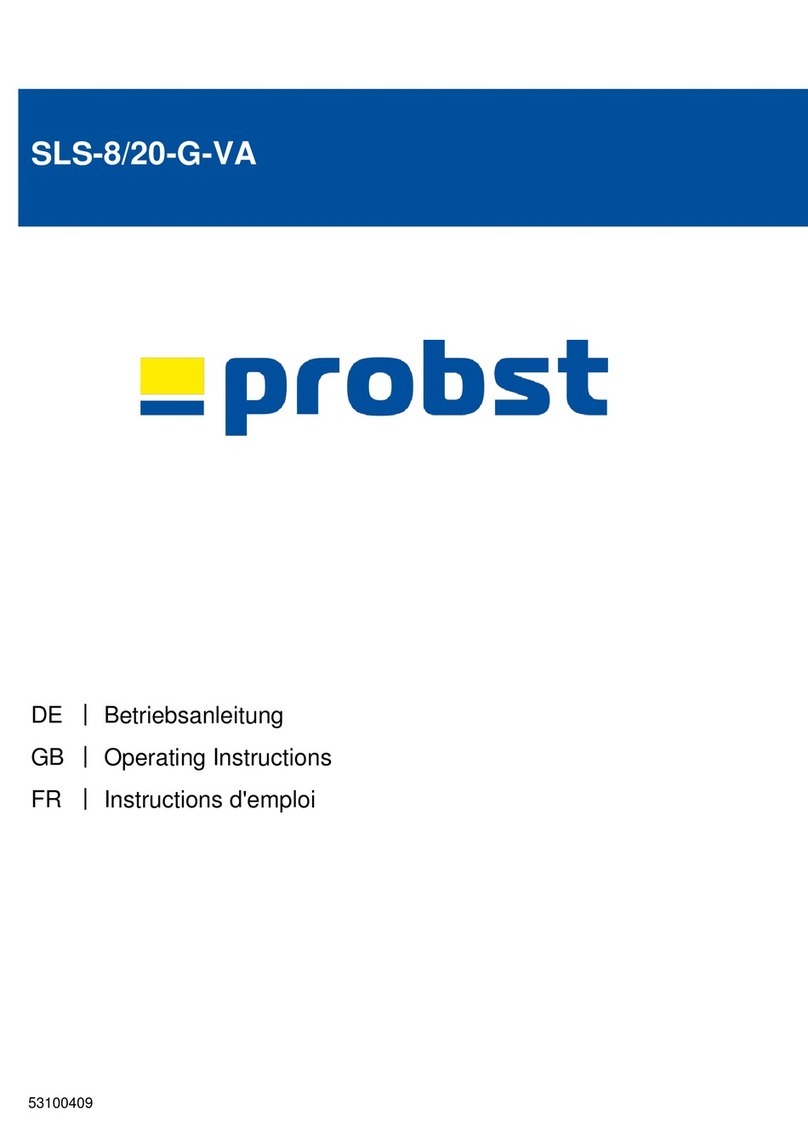
probst
probst SLS-8/20-G-VA User manual

probst
probst TSZ-UNI User manual

probst
probst STAZ-SLC User manual
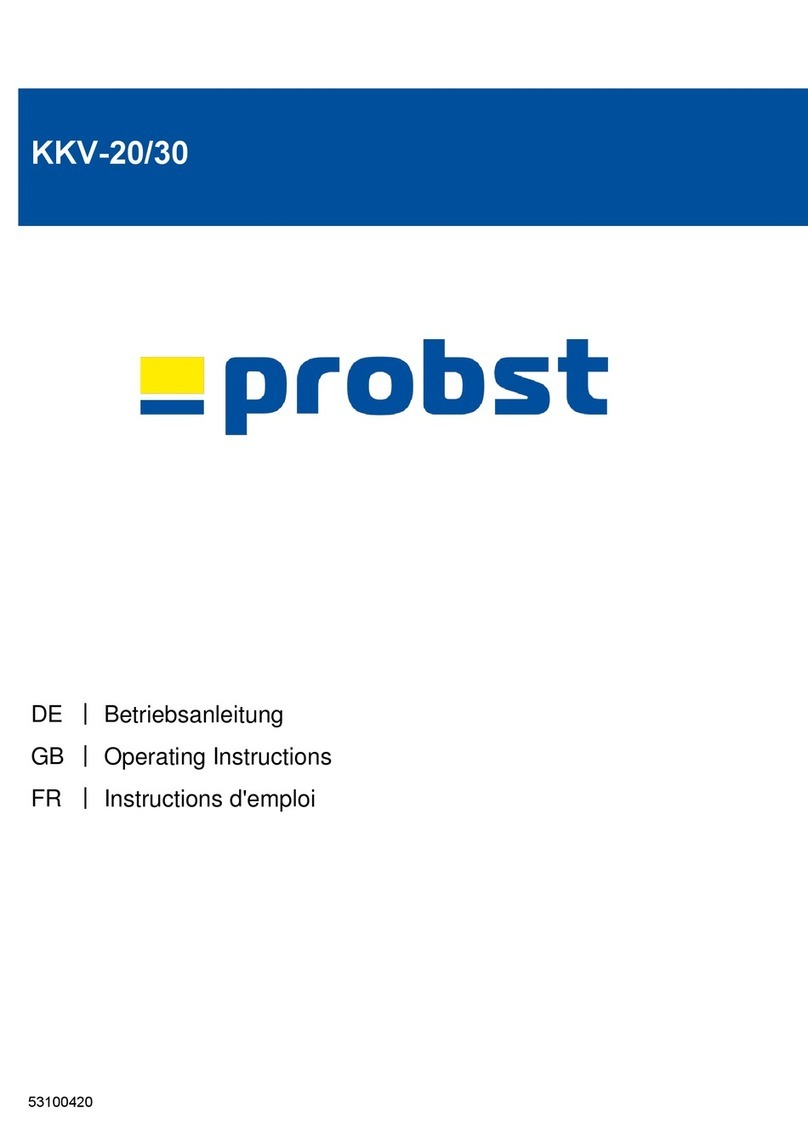
probst
probst KKV-20 User manual
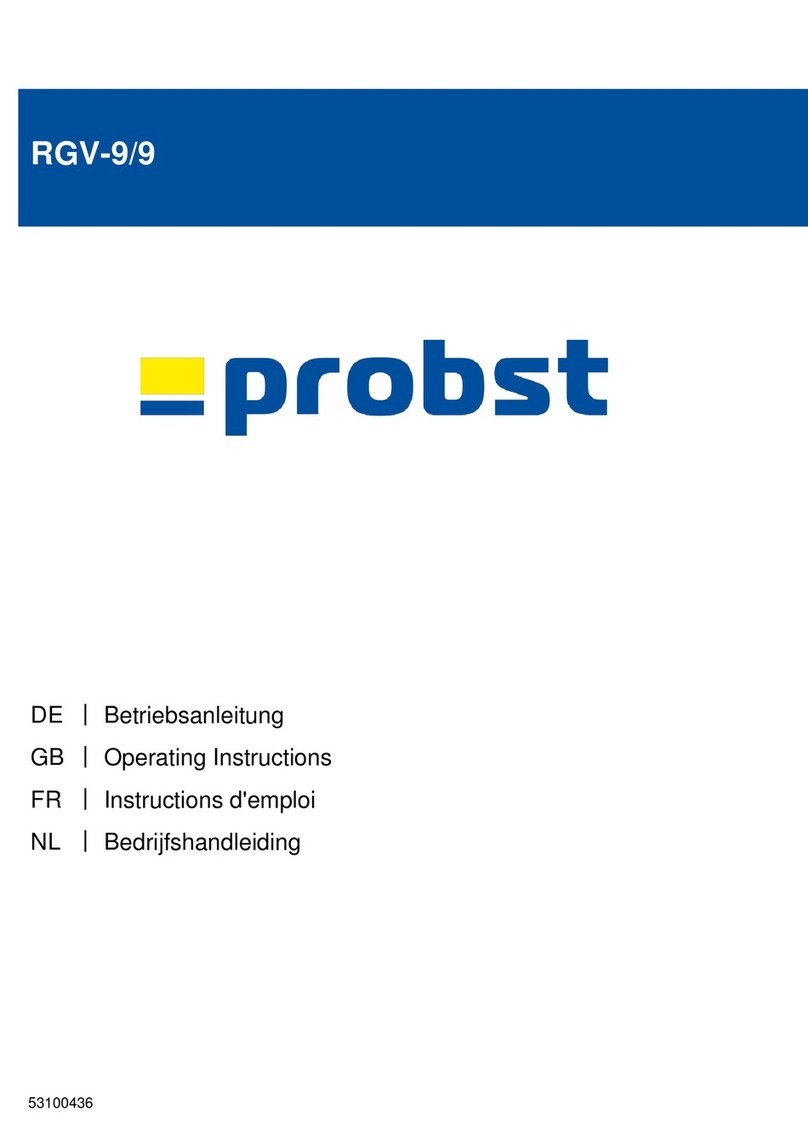
probst
probst RGV-9/9 User manual
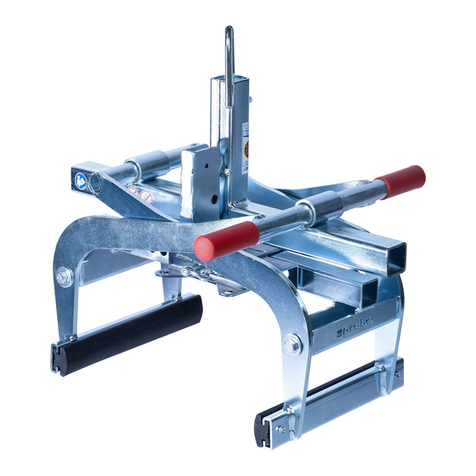
probst
probst TSZ-UNI User manual
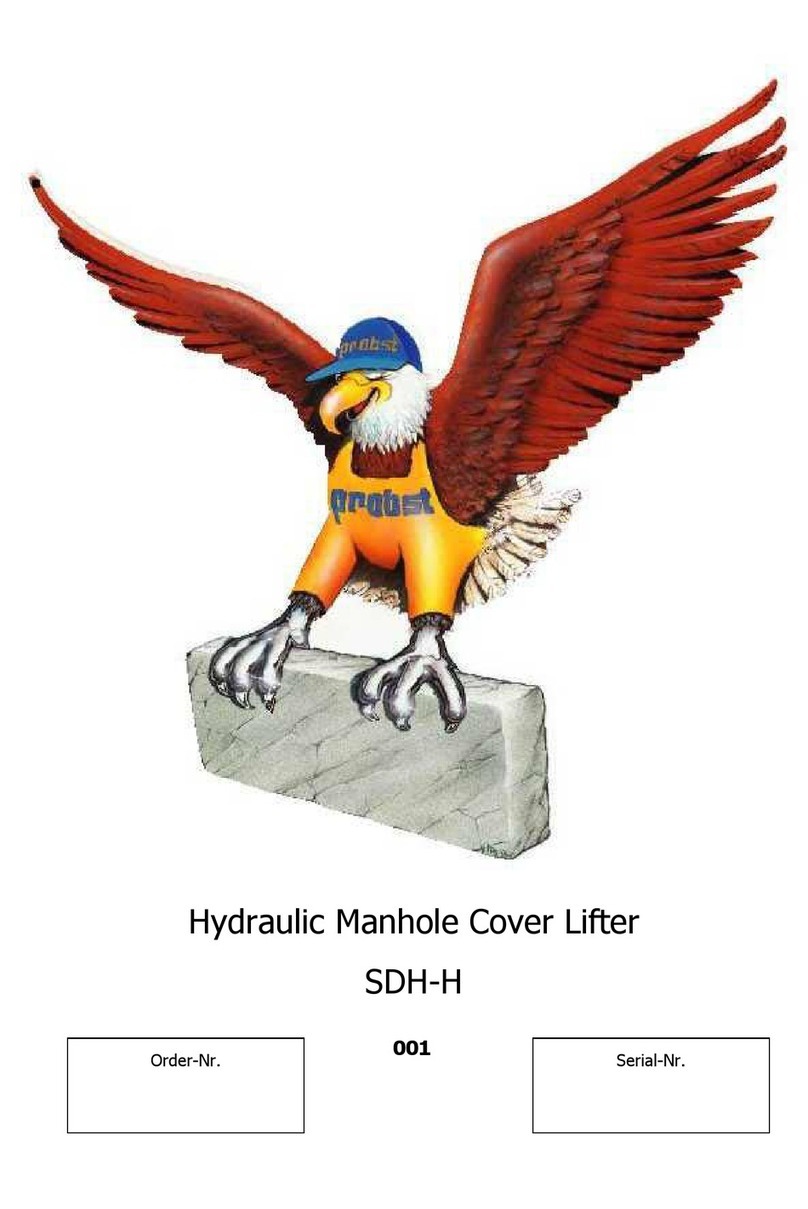
probst
probst SDH-H User manual
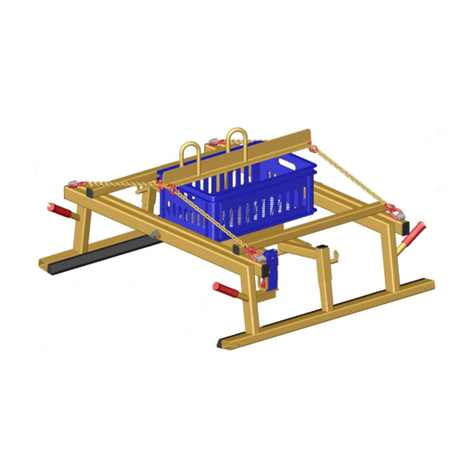
probst
probst DEZ-UNI User manual
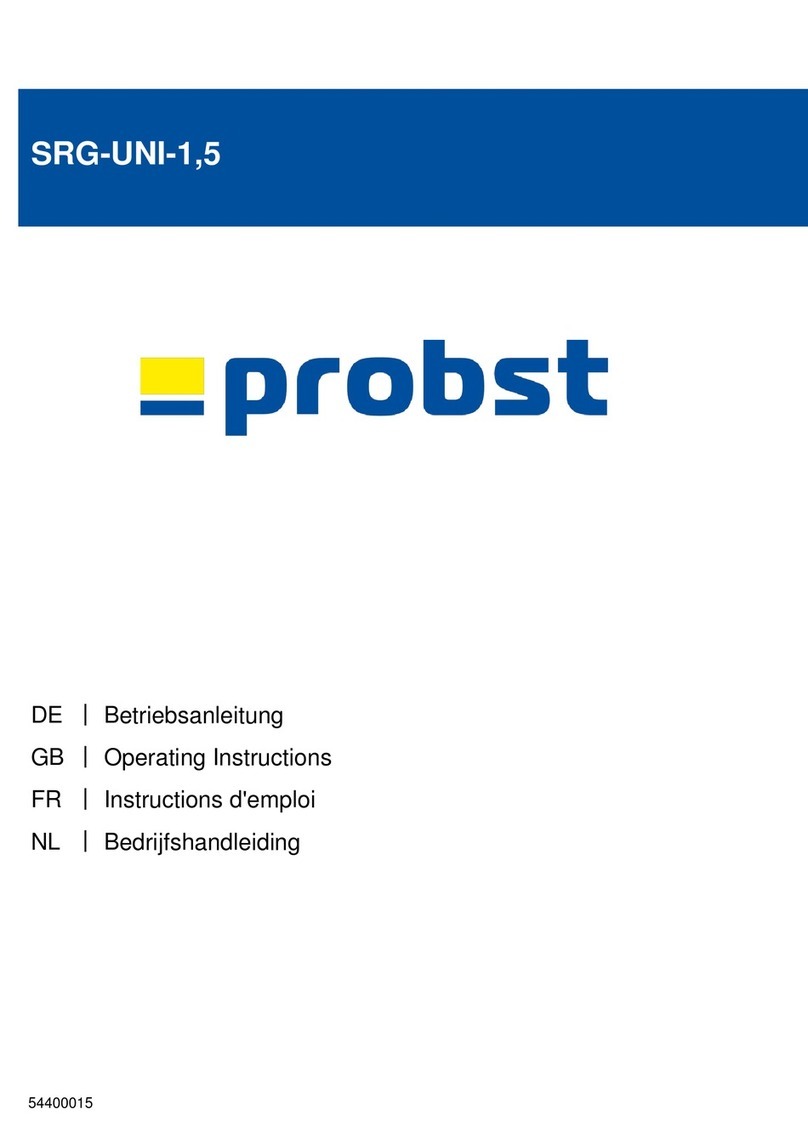
probst
probst SRG-UNI-1.5 User manual
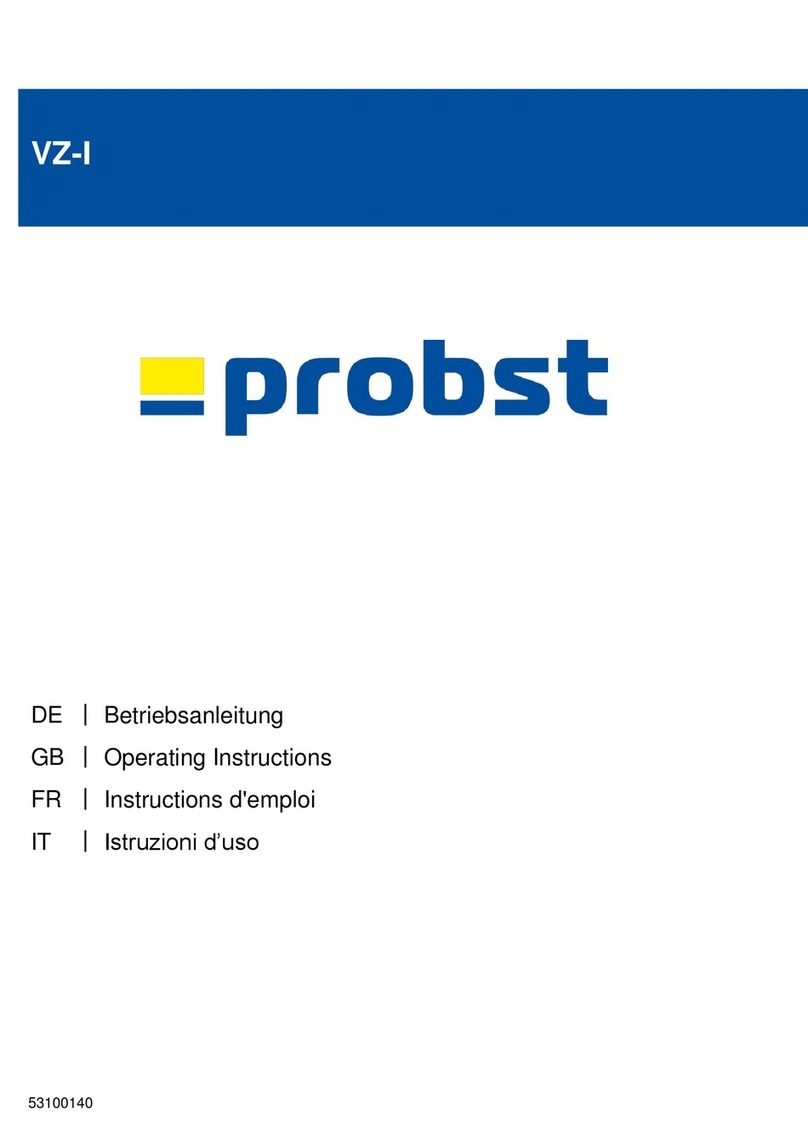
probst
probst VZ-I User manual
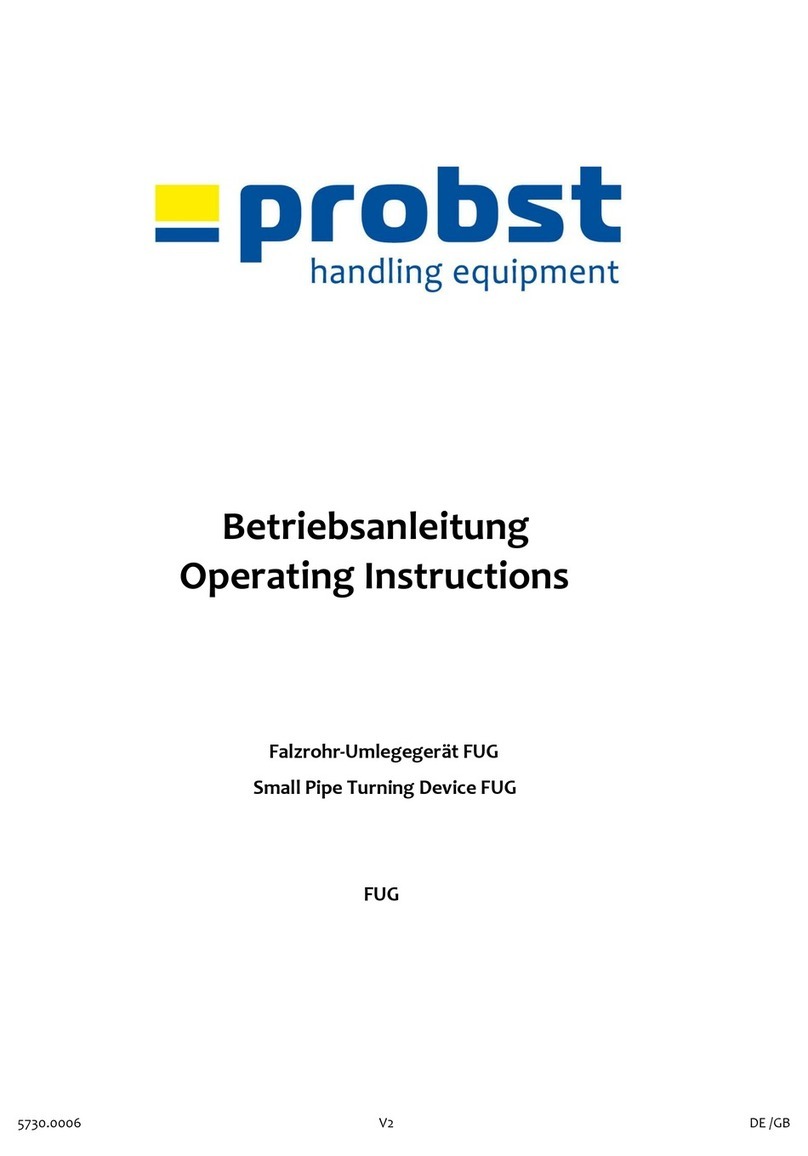
probst
probst FUG User manual
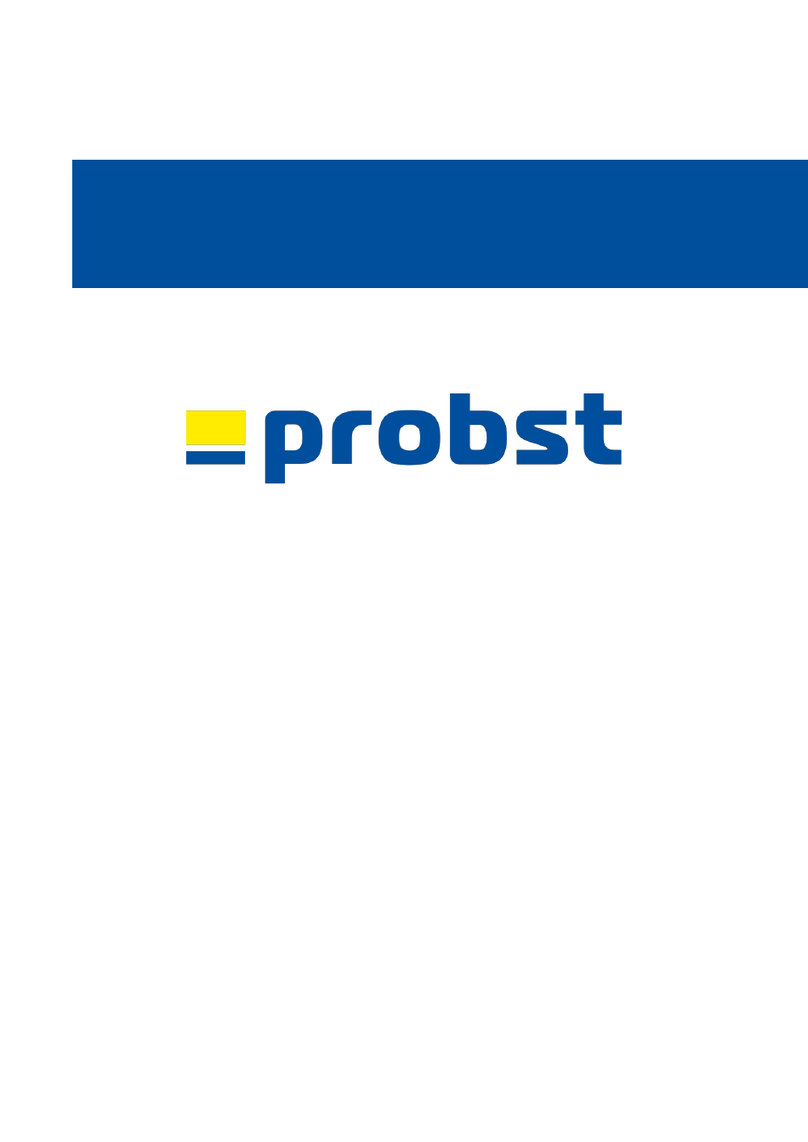
probst
probst SRG-UNI-3-K User manual

probst
probst EASYFILL EF-H User manual
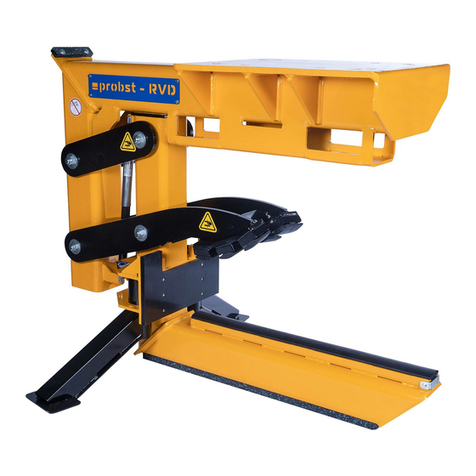
probst
probst RVD-4,5-ECO User manual
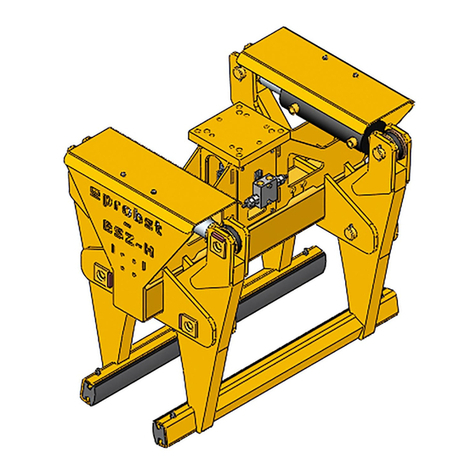
probst
probst BSZ-H-2.0 User manual

probst
probst HVZ-UNI-II User manual

probst
probst HVZ-ECO User manual
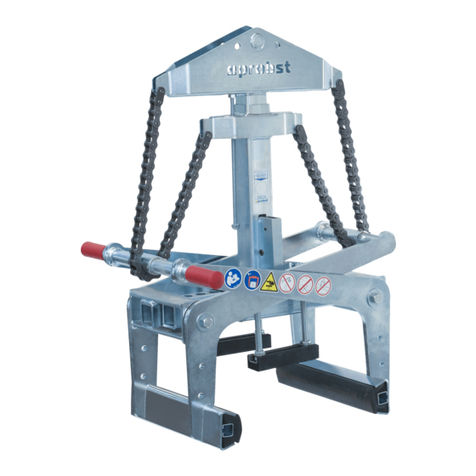
probst
probst FTZ-UNI-25 User manual
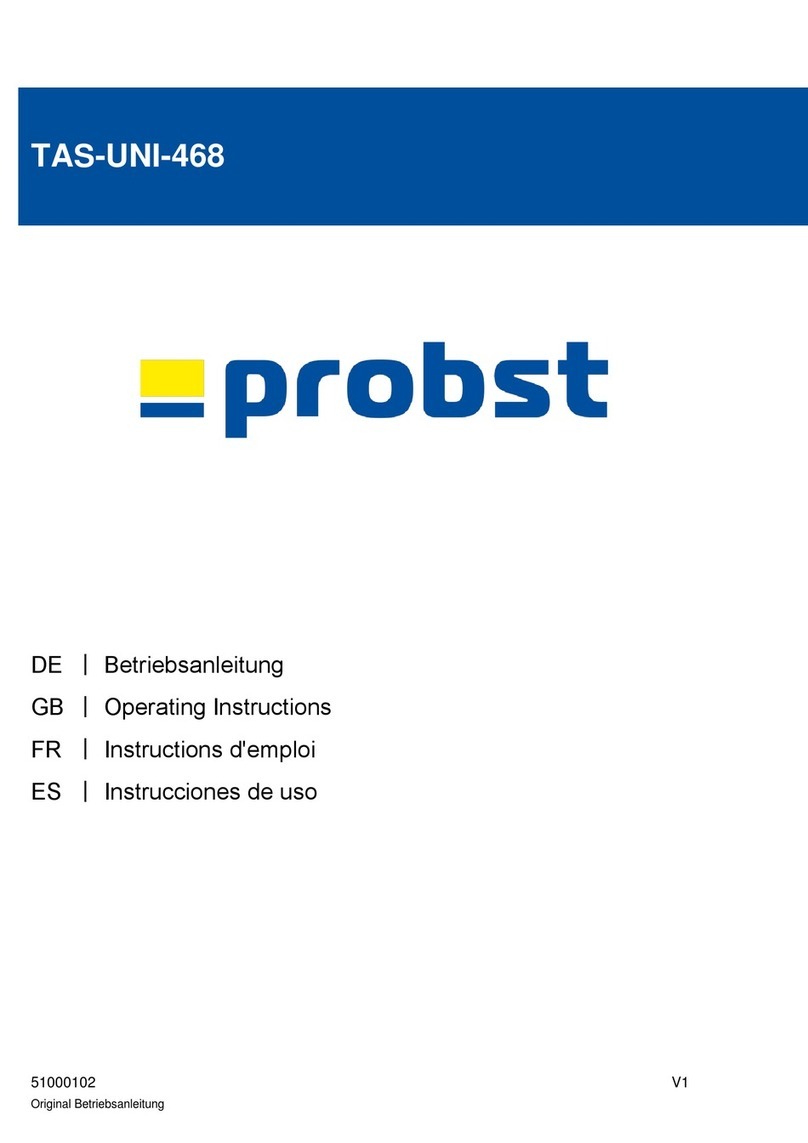
probst
probst TAS-UNI-468 User manual
